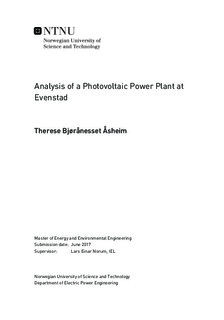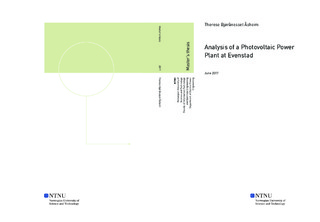| dc.description.abstract | The aim of this master's thesis is to investigate the performance and operation of an existing grid connected PV power plant located at Evenstad in Norway. The PV system has a power rating of 70 kWp and has been operating since November 2013. Measurements of meteorological data and performance data are available for all years of operation. The assessment carried out on this PV plant may be of great significance to the PV industry in Norway. A goal for this thesis is to gain knowledge about performance and operation of PV systems in Norway, which may be of use in the development of the PV industry in Norway.
The first part of this thesis gives an introduction to the theory behind solar energy. This includes the explanation of the solar resource and the PV system with it's main components. This is knowledge necessary to understand the content of this thesis. The demands and requirements for grid connected power plants are also presented. To carry out the evaluation of performance and operation of the PV system at Evenstad, a model of the real system is established in the simulation software PVsyst. The next part of the thesis gives an introduction to this simulation software. The simulation model with the implemented settings and parameters is presented, and the reasons why selecting them are justified. Real meteorological data measured on-site is used in simulations to achieve correct comparisons of simulated production and measured production. Variations of the simulation model were used to obtain different studies.
The results of the thesis are divided into four main parts: A discrepancy analysis of the simulation model, simulations and study of one inverter, daily simulations and at last monthly simulations. In the discrepancy analysis the effect of the implemented parameters are analysed, and the results reveal which parameters are important to implement in the model for the system at Evenstad, in order to achieve accurate results compared to real measurements. Correct settings for the module and horizon line in the model proves to give the most impact on the results of the simulations. It is concluded that the relevance of the different parameters varies according to the system analysed. The study of a single inverter in the system provide an overview of the operation and design of the system. Factors like power ratio and power limit for the inverter are proven to be important to implement correctly in the model according to the actual operation of the inverters, to obtain accurate results. Study of the operation of the system implies that the system was installed with too many modules in order to meet the customers demand. Simulations of daily and monthly time frame show that the model give quite accurate results when comparing simulated production to real production. When performing this comparison for the month of May 2017, the difference becomes as low as 0.3 %. This indicates that the system is performing exactly as anticipated, and that so far there is negligible degradation of the system performance. | |

